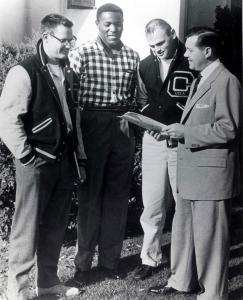“The debate over critical race theory,” reported Christianity Today a few weeks ago, “has landed at Cru, one of the country’s most prominent parachurch ministries.”
Cru – formerly Campus Crusade for Christ – is a behemoth in not only the world of American evangelicalism, but around the world. A few statistics suffice. $750 million in annual global revenue (2020). Nearly 20,000 staff members around the world, each relying on a large network of donors.
Cru’s former name was misleading. While campus ministry is Cru’s origin story and remains at the heart of its evangelism, Cru is really an organizational umbrella containing a large number of evangelistic ministries. FamilyLife, Josh McDowell, Athletes in Action, the Jesus Film, and so forth.

Bill Bright, who founded Campus Crusade in 1951 through his student evangelism at UCLA, was renowned for his laser-like focus on evangelism. Bright passionately preached, over and over again, that all Christians are called to personal evangelism. When he visited congregations and other gatherings, he would ask those in attendance what could possibly be more important than sharing the gospel of Jesus Christ with others? And, he would often continue, when was the last time you did that? By all accounts, moreover, Bill Bright practiced what he preached.
Since Bright’s 2003 death, Cru has had two other presidents: Stephen Douglass and (as of September 2020) Steve Sellers. Douglass was on staff for decades prior to succeeding Bright, and Sellers has been with Cru since 1976.
Given this high degree of institutional stability, Cru seems an organizational unlikely to drift quickly from its evangelical and evangelistic foundations. Yet that is precisely what a sizeable group of Cru’s staff members have alleged.
In “Seeking Clarity and Unity,” these staff members – some named, some anonymous – allege that “elements of the victim-oppressor worldview have permeated our ministry, creating havoc.” In particular, these internal critics maintain that beginning in 2015, Cru invited speakers who in their advocacy against racism and for diversity sowed distrust and division. “The entire program,” the critics state, “main sessions and seminars, were given over to the most radical social justice and CRT communicators.” The result of this new ideology, they assert, has been mission drift away from evangelism and the departure of longtime staff members and donors.
The authors and supporters of “Seeking Clarity and Unity,” however, are not the only Cru staff members discontent with the organization’s current handling of race and justice issues. Others believe that Cru’s top leadership remains tone-deaf on the issue of racism in the United States and has failed to take necessary steps to diversify the top echelons of the organization. For instance, some criticized Steve Sellers for what they perceived as an inadequate response to the murder of George Floyd. “If I call this out specifically,” Sellers wrote shortly after Floyd’s death, “why not every example of racism?” And why not publicly speak against abortion, “the horrors of women being trafficked or … the assault on the biblical view of human sexuality?” When the organization elevated Sellers and two other white staff members to top positions of leadership, some staff members questioned why Cru’s board had not more vigorously recruited candidates from other backgrounds.
I don’t have any insight into the particulars of these internal organizational divisions. Back in the early 2000s, I wrote a history of Campus Crusade for Christ, but since its 2008 publication I haven’t closely tracked Cru’s subsequent course.
Here are some thoughts, though, about the current moment, guided by some historical reflection:
- Bill Bright and Campus Crusade for Christ never had a single-minded focus on evangelism. They maintained an overriding focus on evangelism. There’s an important difference. From the start, Bright had additional – not ulterior, but additional – goals and motives. He came of age in the early Cold War. Like his mentor Henrietta Mears, Bright saw his crusade as both a crusade for Christ and a crusade against communism (both good goals, in my opinion). As time passed, Bright dabbled in conservative politics and occasionally spoke out on many issues beyond evangelism. He also supported the development of ministries such as FamilyLife, which in addition to promoting faith-filled and harmonious marriages and families, defended a complementarian understanding of the church and family. To be fair, these other interests never distracted Bill Bright from evangelism for very long. But Bright and other CCC leaders have taken stands on many issues that they perceived as important for the gospel.
- Mission drift is a perennial concern for theologically conservative American Protestants. “The most cautionary tale for organizations like Cru,” write the authors of “Seeking Clarity and Unity,” “is the Student Volunteer Movement, a ministry much like ours. At its height, around 1920, it was sending over 1,000 students a year into foreign missions. Now called the YMCA, it’s known mostly for its community athletic centers.” Whether it’s denominations, seminaries, or parachurch organizations, there are plenty of organizations that drifted far from their founding theological principles. Whether they came of age in the 1960s or the 1980s or early 2000s, many conservative evangelicals are quick to worry that “social justice” might displace evangelism and discipleship as primary concerns within their organizations. At the same time, many younger evangelicals hunger for their churches and organizations to take clear stands against racism and other injustices.
- Race is not a new issue within the world of American evangelism, but this is a different moment. White evangelical churches and parachurch organizations have at best a very checkered record on matters of race and racism. One African American staff member with Cru once told me of his discomfort when Bill Bright would talk about returning the United States to its Christian roots, reversing some of the problems that began in the 1960s. As the staff member pointed out, before the 1960s there was segregation. Do we really want to go back to that golden age? For the most part, white American evangelicals were deeply uncomfortable with if not outright opposed to the Civil Rights Movement. Eventually, they came to celebrate the movement’s gains and, as in the Promise Keeper’s Movement of the 1990s, accept the need for racial reconciliation. But what most white evangelicals wanted was quick reconciliation, an ability to repent, reconcile, and move on. And given the leadership structures and demographics of evangelical churches and parachurch organizations at the time, they largely could and did move on. I think that’s less possible today. Given this long history of evangelicalism and race, though, the heart of the issue isn’t CRT.
- “How good and pleasant it is when brothers live together in unity!” And how destructive it is when they don’t. Back in the 1950s, CCC was part of evangelicalism’s emergence from within American fundamentalism. For CCC, this was like a painful divorce. A number of CCC staff members were graduates of Bob Jones University, and Bright had made trips to BJU. When Billy Graham and Bob Jones Sr. split over the matter of cooperative evangelism, it sparked painful ruptures within other churches and organizations. For CCC, this divorce was painful. Those staff members who stuck with CCC found themselves persona non grata at BJU. Many personal relationships became strained. Likewise, the news about Cru today makes it clear that the present disunity is straining and sometimes sundering friendships and organizational relationships.
If the Southern Baptist Convention and Cru have deep fissures over these issues, you can bet other evangelical denominations and parachurch organizations are in for bumpy rides in the years ahead.













